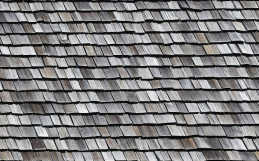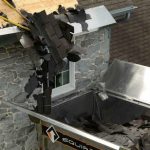(Updated July 27, 2022)
While new roofing material gets all of the oohs and ahhs, what’s happening underneath the asphalt shingles, cedar shakes, or slate tiles are just as important. If there is an issue with the roofing, the next line of defense is the underlayment. Along with decking, these three layers make up the bulk of your roofing system.
The best roof underlayment layer provides waterproofing, which is extra protection against snow, ice, and water damage to your home. It’s installed after the roofing decking (plywood sheets in most cases) and before the shingles go up. Without this important layer, your home may be vulnerable to water damage, threatening your safety and putting your home investment at risk.
Usually, a roof underlayment is crafted from fiberglass, which is then impregnated with waterproofing agents and asphalt. The main types of roofing underlayment are asphalt felt, non-bitumen synthetic underlayment, and rubberized asphalt. All three have their uses, benefits, and advantages.
If you are looking for a way to protect your roof, you benefit from learning about the best roof underlayment for your situation. If you’re wondering what the best roof underlayment is, there are a few different things to consider. Cost is an obvious factor, but shouldn’t be the only thing you think about.
What is the Best Roof Underlayment?
In general, the asphalt-saturated felt is utilized for residential applications where a steep slope is present. Each type of underlayment serves its own purpose and a roofing expert will know which one is right for your home. All will offer high levels of protection against moisture and have varying degrees of fire resistance.
Synthetic Roof Underlayment
While asphalt roofing felt was the standard for decades, synthetic roofing underlayment is a very popular choice. There are several manufacturers available on the market, including Owens Corning, Tyvek, RhinoRoof, and more. They are lighter than other underlayments, have a high tear strength, and are considered waterproof instead of water-resistant.
A high-performance synthetic roof underlayment will also have some non-skid properties that help during installation. They are resistant to UV rays and can be exposed to the weather for months on end without deteriorating. As with any underlayment, synthetic underlayment is at its most effective when installed correctly, especially at the edges.
Roofing Felt
There are two standard types of asphalt-saturated felt underlayment: 15 and 30 felt. This refers to the weight of the felt over one roofing square, which is 100 square feet. If you’re using 15 felt, that means a roofing square will weigh 15 pounds. The 30 felt material is much stronger and will stand up to the elements much better.
However, felt should not be left in the elements for too long. The sun’s UV rays and rain will accelerate deterioration. Depending on the slope of the roof, there are differences in overlap during installation as well. The material is also water “resistant” and may absorb water during installation, which can lead to wrinkling and disrupt lighter shingles.
Rubberized Asphalt
With a “peel and stick” installation process, rubberized asphalt products are self-adhering and self-sealing. This means they seal around staples or nails used during the installation of roofing materials. This underlayment is lightweight and strong and most have non-skid properties.
This product is often found in areas that deal with interruptions in the roofing, such as vents, chimneys, and skylights, or where water collects, such as valleys. They also stand up well in high temperatures, which makes them a good choice for metal roofing.
How to Find a Contractor
If you are interested in getting the most appropriate underlayment for your roof, you should know that finding a skilled and experienced roofing contractor will be the key to accessing superb quality. When shopping for a contractor, be certain to look for one who has a strong and positive reputation in their community.
It’s pretty easy to look up roofing industry reviews these days, like on Angie’s list, and doing so is a great way to find the best contractors without needing to invest a whole lot of time and energy.
When you arrange for a consultation, a roofing expert will be able to suggest the best roofing underlayment materials for your type of home and your local climate. He or she will also be able to provide you with a quote for services. This will typically be a free, no-obligation quote.
Once your underlayment is in place, you’ll know that you’ve done all that you can to protect your home from water damage. Without the underlayer, you may find that you will be paying for expensive repairs related to water damage down the road. So, why not find a contractor today?
For a free quote on roof underlayment, contact the roofing experts at Warner Roofing.







